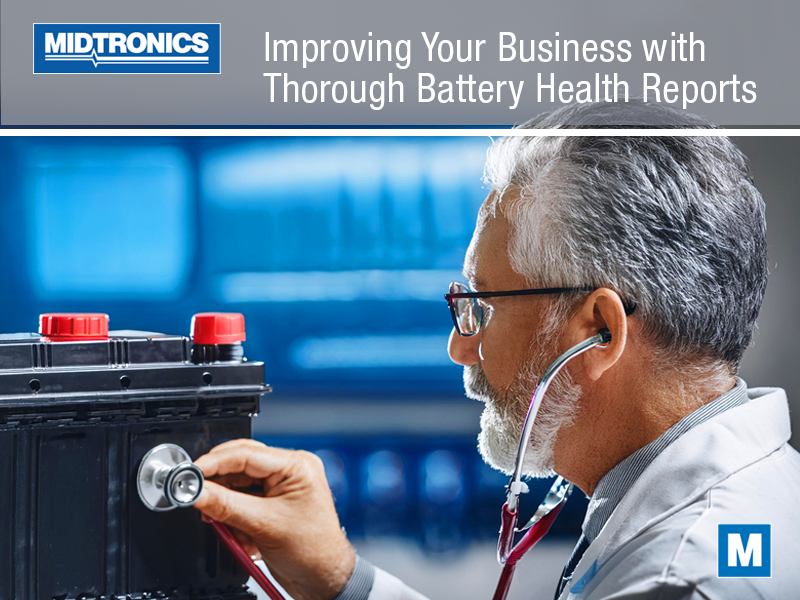Whether you’re a vehicle owner or a shop owner, a car battery is something you’re familiar with. Most people know that it has a positive and a negative post and it’s 12-volt, but the composition is often misunderstood. For sealed lead acid batteries, or SLA batteries, that’s especially true. They’re confused for their cousin, the flooded lead acid battery and erroneously dissociated with absorbent glass mat (AGM) batteries.
Drivers, mechanics, and shop owners alike can benefit from understanding 12-volt SLA battery technology. Not only will it help with today’s vehicle servicing, but many EVs also use this type of lead-acid battery. These are the features and benefits you can see with SLA vs flooded lead acid batteries.
What is a Sealed Lead Acid Battery?
Sealed lead acid batteries are very similar to other lead acid varieties but with some small yet important differences. Their construction includes:
- A polypropylene resin case that contains all the other components
- Negative plate packs covered in lead material
- Positive plates containing lead oxide
- Separators to keep the negative and positive plates isolated
- Electrolyte material suspended in a liquid or gel
- A valve to vent excess pressure
The term ‘sealed’ is an important one for this type of battery. Rather than vent the gases from inside the battery during use, SLA batteries use a recombination process that hitches the oxygen and hydrogen molecules back together, returning them to a liquid state. The top of the battery case is sealed to prevent the electrolyte from spilling or venting out. However, there is a vent that releases pressure should it be too great.
Features of An SLA Battery
Like any product, different types of batteries have characteristics that are unique to that type. The more advanced usually has advantages in performance, and you’ll find that to be the case for SLA batteries over flooded varieties.
Maintenance Free
An SLA battery is touted as maintenance free since the risk of spills is essentially nil. Flooded car batteries can’t claim the same thing since the gases that vent release into the atmosphere and can’t be recovered, meaning that the electrolyte will eventually need to be topped up or the battery won’t be any good anymore.
AGM batteries also fall into this category. The electrolyte is suspended in a fiberglass mat between the lead plates so it won’t spill. They’re even more durable and can be oriented on their side where flooded cell batteries must always be positioned with the vents on top.
Lower Cost Than Li-ion Options
SLA batteries are a step up in price from basic flooded lead acid batteries, but not so much that it’s unaffordable for most people. And while lithium-ion batteries that are respected as more powerful, lighter, and safer, stepping up to li-ion increases the cost several times, not just by a few dollars. And for almost all applications, SLA batteries will far exceed the demand that the user puts on it.
For example, a $150 SLA battery can be found in many EV models to power electronics. If a li-ion battery were used in its place, the performance difference would be indistinguishable but the cost could be $800 or more.
Long Service Life
The average flooded battery lasts between three and five years for most automotive applications before it needs to be replaced. Depending on the manufacturer, SLA batteries can range as high as 12 years in service, though the average is closer to five years. That’s with normal use, and any SLA battery that’s allowed to fully discharge will suffer loss of capacity as a result, just like flooded ones.
AGM batteries and li-ion options have a longer life expectancy of six years or higher, but that comes at a cost. For the average commuter who owns a vehicle for an average of six years or so, the benefit to installing an AGM or li-ion battery in their vehicle won’t pay off.
Built Tough
Since an SLA battery doesn’t always have to be installed vertically, it’s even more important that it can withstand harsh conditions. Almost all automotive batteries are assembled inside a rugged polypropylene resin case that is resistant to impact, vibration, heat, and corrosive materials, but the fact that SLA batteries are sealed and can be used in equipment and vehicles that experience these conditions frequently makes that aspect even more crucial.
For instance, a pickup truck running people up and down a logging road can’t chance the electrolyte spillage that’s possible with flooded lead acid batteries. But an SLA battery, particularly an AGM battery, can take the abuse without any effect at all.
Why It’s Important to Know
For vehicle owners and fleet managers, it’s easy to choose a replacement battery based on cost alone, especially when the expense isn’t expected. However, the battery you choose can affect how you can use your vehicle, the maintenance it needs, and when it’ll need to be replaced again. If you aren’t aware that a flooded battery needs the electrolyte level checked and topped up, the battery could die prematurely and adding another unexpected cost, not to mention the frustration it comes with. That can mean costly downtime for a fleet vehicle, for instance.
And for shop owners and mechanics, understanding the workings and benefits of an SLA battery versus lower options (flooded) and higher choices (AGM and li-ion) can help boost your sales rate when a battery is needed. By explaining the benefits that come with SLA batteries, you can install a better battery for a customer without scaring them away with the exorbitant cost of the high-end options.




